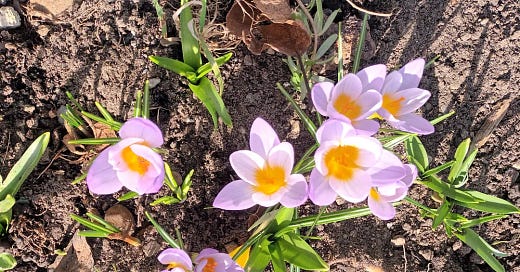‘SPRING … Daffodils all out; garden set with thick golden crocuses; snowdrops almost over; pear trees budding’ (Virginia Woolf, diary entry for March 3rd, 1920).
It is only just March, but crocuses are everywhere. On my windowsill, Crocus x leonidii ‘Early Gold’ is showing off brown hen’s-feather markings. By the gate, pale purple buds push through the dry leaves under the crabapple tree. A friend has shared pictures of her lawn, where, unbeknownst to her, a previous owner naturalised thousands of bulbs, surprising her in the spring with their carpet of colour. I read that the flowers are symbols of St. Valentine, emblems of romance and desire. On twitter, yet another image of crocuses bursting into bloom introduces a statement on the etymology of the word. The Ancient Greeks had κρόκος and Hebrew karkōm, we’re told; in Old English the word for saffron was croh. Remarkably, the author claims, the word ‘crocus’ was then lost until the sixteenth century.
Such an etymology is engaging: we stop to wonder what it would be like to experience a language with no word for crocus. Did medieval speakers overlook the brightness of those petals, without that cock-crow of a name? Did they miss something vital? How could they fail to find a word for something so vivid?
It is true that there is an aspect of the crocus that is unspoken, or unknown. These spring bulbs and their autumn-flowering cousins feature repeatedly in Virginia Woolf’s writings. In Mrs Dalloway, the memory of a lesbian kiss is ‘a sudden revelation … a match burning in a crocus; an inner meaning almost expressed’. I doubt Woolf knew, but the choice of flower is delightfully, botanically apt. These yonic stigmas of the crocus are part of the female reproductive system of the plant (though Ezra Pound, not on top form, refers leeringly to the ‘gilded phalloi of the crocuses’). But the saffron crocus is not interested in heterosex: it can only reproduce artificially. As the non-biological lesbian mother to my daughter, I am tickled. Here is this unmistakable sign of nature bursting into action, and it turns out to be resolutely un-straight.
Dig a little deeper, and those not-so-straight crocuses turn out to be not-so-silent, after all. Our etymologist’s assurance that medieval English had no word for crocus comes from a dictionary that prioritised print sources over manuscript evidence, and so elided a whole section of pre-print English linguistic history. A quick search through the Middle English Dictionary reveals crocuses bursting up through the pages of medieval texts. ‘Saffron hatte [is called] crocus and is an herbe,’ the medieval encyclopaedia-writer Trevisa tells us; engagingly, the physician Chauliac prescribes crocus to purify and stimulate the blood and explains that ‘crocus is a flour [flower] … with comfortacioun and resolucioun’.
Plants and histories of words have always jostled together in my mind. Every etymology claims to root the speaker back into the deep soil of language. When my daughter was born, I found myself particularly in need for roots, both in language and in nature. The language of mothering is deeply connected with the idea of nature. The stories and social narratives of motherhood we inherit seem to have no room for a second mother, and othermother, a person for whom there is no proper language. A crocus that dare not speak its name. In this space, I plan to write about that process of finding roots, and finding words, in the garden.
*
The edition of Virginia Woolf’s diaries I cite is The Diary of Virginia Woolf, ed. Anne Olivier Bell, assisted by Andrew McNeillie, Vol. 2 (1920-1924) (New York and London: Harcourt Brace Jovanovich, 1978).




